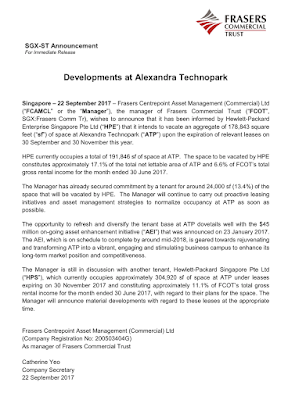The much anticipated news is finally released. It is confirmed that HP
will be vacating 178,873 square feet of space out of their current 191,846 square feet of space in Alexandra Technopark
based on the expiration of their leases. This will also mean that they are vacating 93.2% out of the space they're currently occupying.
The space they are vacating will constitutes to about 17.1% of the total net lettable area in ATP and 6.6% of FCOT's total gross rental income for the month ended in 30 June 2017.
The manager of FCOT has secured commitment by a tenant of about 24,000 sqft (13.4%) of the space vacated by HP. As such, the drop of FCOT GRI at this point will stands at 5.71% and 14.8% of total net lettable area in ATP.
 |
| FCOT's announcement on 22 September 2017 |
Is their HP's departure good?
There's always two side to a coin. As FCOT is pretty dependent on HP's occupancy previously, their departure now will provide them with a chance to further diversify them self with other tenants to reduce concentration risk. It will be up to FCOT's manager to do it's job now to look for tenants. They have also initiated Asset Enhancement Initiative (AEI), which will improves property yield, value of property and occupancy, which will brings up the NAV. This AEI from FCOT on ATP is geared towards rejuvenating and transforming ATP into a vibrant, engaging and stimulating business campus.
Now how bad is it?
Do note that as 6.6% of FCOT's rental income is derived from HP and their partial-to-almost-full departure from ATP will result in a significant drop in their financial result in the coming year. The loss of income will also translates to a drop in their distribution which will affect the returns from a REIT as the returns from REITS are largely dependent on it's DPU.
With reference and taking the previous DPU in FY2016 into account of 9.82cents, the drop of 5.71% will gives me a rough calculation of 9.25cents in their FY2018 DPU. With the price that closed on Friday at 1.395, it will represents a 6.6% dividend yield, if they fails to secure a tenant with AEI going on for the next year.
Now this is a 0.4% drop in dividends.
Don't forget. This departure is only from HP Enterprise Singapore Pte Ltd ("HPE") and there's still 302,920 sq feet of spaces which HP Singapore Pte Ltd ("HPS") is currently sitting on which is constitutes to 11.1% of FCOT total GRI.
Now if HPS fully vacate in November 2017 when their leases is due.
Let's take a look at how it will further impact FCOT
Stripping another 11.1% of FCOT GRI off, similarly, taking FY2016 DPU into account, the drop will now gives me roughly (1-0.111+0.0571)*9.82 = 8.169cents in FY2018. And with the closing price of 1.395 on last Friday, the dividend yield will now be 5.85%. The drop is significant from it's yield of 7% now.
I do remember that HP had previously gotten themselves a built to suit facility from MIT of 824,500 sqft in Depot Road, which is just a stone throw away. Now, when HPE moves over, they're still left with 645,627sqft of space in Depot Road.
 |
| Mapletree Industrial Trust BTS facility for HP |
So there's a great chance that HPS will be moving over to their new premises.
If HPS is totally vacating, they will need to look for tenants that will takes up 304,920 + 178,843 = 483,763 sqft of space in Alexandra Technopark. It seems like the worries about FCOT previously is now coming true.
Currently, at 1.395, FCOT is trading at a 9% discount to their NAV.















